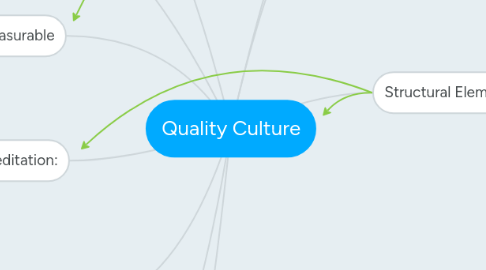
1. Institution culture varies and changes - quality culture must adapt
2. Enabling Factors
2.1. Commitment
2.1.1. A necessary condition of quality culture as well as a result of quality culture
2.2. Negotiation
2.2.1. Between students and teachers
2.3. General and specific competences for quality development
2.3.1. Professionalization – building knowledge, skills and attitudes of stakeholders in higher education organization
3. Quality culture Element
3.1. Culture, values, norms = the underlying concept for organizational improvement in higher ed performance
3.1.1. Observable behaviour, espoused values, underlying assumptions
3.1.2. Organization of work, technology, organizational structure, business strategy and financial decision-making
3.2. Manifestations in existing assumptions about quality and teachings, newly discussed and shared values, rituals and tangible cultural artefacts
3.3. Not a uniform concept
4. Transversal Elements
4.1. Total systems/Holistic approaches
4.1.1. Communication
4.1.2. Participation
4.1.3. Trust
5. Measurable
5.1. We can measure quality using indicators: student success, student achievement, and surveys of staff and students
5.2. External and Internal audits of the institution can be done to measure quality, keeping in mind the key values of transformation and perfection
6. What are the difficulties in maintaining quality in education?
6.1. Our stakeholders change year to year: therefore so do their demands and needs
6.2. Education is not completely "corporate" so it is hard to predict what services and products will be needed in the next year
7. Accreditation:
7.1. Accreditation standards differ in every country, therefore it is very challenging to assess quality globally
7.1.1. Recognition agreements must be made between partner universities early on
7.1.1.1. The huge difference in standards makes developing a universal QA framework very difficult
8. Structural Element
8.1. New Public Management approaches - Structures, accreditation, rules, regulations
8.2. Total quality management (structural elements) – organizational culture and quality in wholeness of organizational factors – attitudes and skills of teachers, abilities and motivation of learners, organizational background, contexts and values, existing structures such as rules, regulations, legislation etc
8.2.1. i. Approaches to quality (management) planning
8.2.2. ii. Best and good practice examples/guidelines, benchmarking
8.2.3. iii. Quality certification and accreditation on different levels
8.2.4. iv. Quality competition and awards
9. What IS quality?
9.1. It is TRANSFORMATION based
9.1.1. It is PERFECTION: do we strive for it as an institution?
9.2. It is FITNESS FOR PURPOSE: the reason to keep programs up to date
10. What does quality look like in online education programs?
10.1. Online education programs are not widely accepted: even some faculty doubt the success of their programs
10.1.1. Assessing quality for online programs requires very different methods
10.1.2. Online programs vary greatly: some have high student interaction levels, where as others are merely testing and assignment based. How can they be assessed the same way if they are so fundamentally different?

